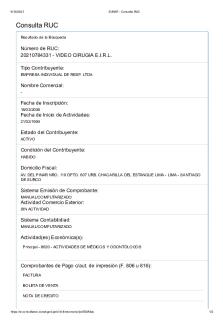cellebiologi - RUC PDF

| Title | cellebiologi - RUC |
|---|---|
| Course | Eukaryot cellebiologi |
| Institution | Roskilde Universitet |
| Pages | 3 |
| File Size | 119.8 KB |
| File Type | |
| Total Downloads | 102 |
| Total Views | 132 |
Summary
Download cellebiologi - RUC PDF
Description
Lecture II Problems: lipids and carbohydrates (chapter 5B) Lipids: 1. (L) Solve: “Synthesize your knowledge: Chapter 5, p139
A developing chick is growing rapidly, increasing its number of cells. To build new cells it needs large stores of cell membrane components, including cholesterol and lipids, and other cell components such as proteins. It also requires energy to fuel all this construction, and that is available in the form of fats. Fat molecules are a rich source of energy when metabolized 2. (S) Polymers are made of monomer subunits that are joined by what type of bonds? 1. ionic bonds 2. covalent bonds 3. hydrogen bonds 4. hydrophobic bonds
3. (S) Which four chemical elements (grundstoffer) are used in the cell to form fatty acid, and carbohydrates? Hydrogen, Carbon, Oxygen and Nitrogen. 4. (S) Lipids cannot be considered polymers because 1. they contain polar covalent bonds. 2. their structure includes carbon rings. 3. they can be artificially created. 4. they are not composed of monomer subunits.
5. (S) All lipids 1. are made from glycerol and fatty acids. 2. contain nitrogen. 3. have low energy content. 4. do not dissolve well in water. 6. (S) Which building blocks are used in the cell to form fat?
Glycerol linked to three fatty acid chains 7. (S) Which building blocks are used in the cell to form phospholipids? Glycerol linked to two fatty acids and a phosphate group 8. (S) What is the cellular function of: 1) Phospholipids? Phospholipids makes up most of the cell membrane structure. When they come in contact with water, they make a double-layered sheet called a “bilayer” to shield the fatty acids from the water since the fatty acids are hydrophobic. The phospholipid “bilayer” forms a separation between the cell and the external environment inside the eukaryotic cell. 2) cholesterol? Cholesterol is a big part of the cell membrane – control fluidity of the membrane. Also a precursor for the making of steroids
3) triacylglycerol? - Is a fat and is used to store energy
9. (S) Which of the following substances are carbohydrates, fatty acids, amino acids, polypeptides? a. +NH3 - CHR - COOAmino acids
b. C6H12O6 Carbohydrates
c. (glycine)20 Polypeptide
d. CH3(CH2)16COOH Fatty acids
Carbohydrates: 10. (S) Which polysaccharide has the greatest number of branches? 1. cellulose 2. chitin 3. amylose 4. glycogen 11. (S) Starch and cellulose are both formed by glucose units, but the two substances have different properties. Explain the differences. Glucose exists in two configurations depending on placement of hydroxyl group: α and β → different glycosidic linkage.
Starch: all monomers are in the same orientation → helical structure → granulates in plastids (storage structures in cells) Cellulose: monomers upside down with respect to its neighbours → straight structure → bundles in microfibrils in cell walls
12. (S) A polysaccharide you are studying contains unbranched β glucose molecules and cannot be digested by humans. Which polysaccharide are you studying? 1. cellulose 2. DNA 3. starch 4. glycogen 13. (S) Which statement is true? 1. Glucose is stored in cells 2. Glucose is used directly in metabolism 3. Glucose is to large to pass the cell membrane 14. (S) Which statement is true? 1. Glucogen is stored in cells 2. Glucogen is used directly in metabolism 3. Glucogen is to large to pass the cell membrane
15. (S) Table sugar is a 1) Monosaccharide 2) Disaccharide 3) Polysaccharide...
Similar Free PDFs

cellebiologi - RUC
- 3 Pages

GUIA DE Contratistas RUC
- 66 Pages

modelo de ficha ruc
- 3 Pages

Sunat - Consulta RUC MPB
- 2 Pages

Ficha RUC - Video Cirugia EIRL
- 2 Pages

EXAMEN AUDITOR 1072 Y AUDITOR RUC.
- 35 Pages
Popular Institutions
- Tinajero National High School - Annex
- Politeknik Caltex Riau
- Yokohama City University
- SGT University
- University of Al-Qadisiyah
- Divine Word College of Vigan
- Techniek College Rotterdam
- Universidade de Santiago
- Universiti Teknologi MARA Cawangan Johor Kampus Pasir Gudang
- Poltekkes Kemenkes Yogyakarta
- Baguio City National High School
- Colegio san marcos
- preparatoria uno
- Centro de Bachillerato Tecnológico Industrial y de Servicios No. 107
- Dalian Maritime University
- Quang Trung Secondary School
- Colegio Tecnológico en Informática
- Corporación Regional de Educación Superior
- Grupo CEDVA
- Dar Al Uloom University
- Centro de Estudios Preuniversitarios de la Universidad Nacional de Ingeniería
- 上智大学
- Aakash International School, Nuna Majara
- San Felipe Neri Catholic School
- Kang Chiao International School - New Taipei City
- Misamis Occidental National High School
- Institución Educativa Escuela Normal Juan Ladrilleros
- Kolehiyo ng Pantukan
- Batanes State College
- Instituto Continental
- Sekolah Menengah Kejuruan Kesehatan Kaltara (Tarakan)
- Colegio de La Inmaculada Concepcion - Cebu

